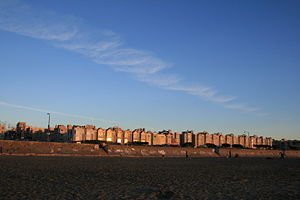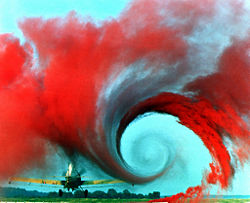Vortex
A vortex (plural vortices) is a rapidly spinning, circular or spiral flow of fluid around a central axis. The swirling motion tends to suck everything within the fluid toward its center. The speed and rate of rotation of the fluid are greatest at the center, and decrease progressively with distance from the center. Examples of vortices range from tornados and hurricanes in the atmosphere to water flowing down a drain. The Great Red Spot on Jupiter appears to be a huge vortex.
Observations and examples
A vortex can be observed in the spiraling motion of air or liquid around a center of rotation. The circular current of water of conflicting tides form vortex shapes. Turbulent flow makes many vortices. A good example of a vortex is the atmospheric phenomenon of a whirlwind or a tornado or dust devil. The whirling air mass mostly takes the form of a helix, column, or spiral. Tornadoes develop from severe thunderstorms, usually spawned from squall lines and supercell thunderstorms, though they sometimes happen as a result of a hurricane.
In atmospheric physics, a mesovortex is the term used for a vortex on the scale of a few miles, that is, smaller than a hurricane but larger than a tornado. On a much smaller scale, a vortex is usually formed as water goes down a drain, as in a sink or toilet. As water flows out of a small opening in the bottom of the basin or reservoir, it forms what is called a whirlpool.
A number of examples of vortices are listed below.
- Electromagnetic fields: In the hydrodynamic interpretation of the behavior of electromagnetic fields, the acceleration of electric fluid in a particular direction creates a positive vortex of magnetic fluid. This, in turn, creates around itself a corresponding negative vortex of electric fluid.
- Magnets: Different classes vortex waves also exist in magnets. They are exact solutions of classical nonlinear magnetic equations, for example, Landau-Lifshitz equation, continuum Heisenberg model, Ishimori equation, nonlinear Schrodinger equation, and so on.
- Smoke ring: A ring of smoke that persists for a surprisingly long time, illustrating the slow rate at which viscosity dissipates the energy of a vortex.
- Lift-induced drag of a wing on an aircraft.
- The primary cause of drag in the sail of a sloop.
- Whirlpool: A swirling body of water produced by ocean tides or by a hole underneath the vortex, where water drains out, as in a bathtub. A large, powerful whirlpool is known as a maelstrom. In the popular imagination, but only rarely in reality, can they have the dangerous effect of destroying boats. Examples are Scylla and Charybdis of classical mythology in the Straits of Messina, Italy; the Naruto whirlpools of Nankaido, Japan; the Maelstrom, Lofoten, Norway.
- Tornado: A violent windstorm characterized by a twisting, funnel-shaped cloud. A less violent version of a tornado, over water, is called a waterspout.
- Hurricane: A much larger, swirling body of clouds produced by evaporating warm ocean water and influenced by the Earth's rotation. Similar, but far greater, vortices are seen on other planets, such as the permanent Great Red Spot on Jupiter and the intermittent Great Dark Spot on Neptune.
- Polar vortex: A persistent, large-scale cyclone centered near the Earth's poles, in the middle and upper troposphere and the stratosphere.
- Sunspot: A dark region on the Sun's surface (photosphere) marked by a lower temperature than its surroundings, and intense magnetic activity.
- Black hole: The accretion disk of a black hole or other massive gravitational source.
- Spiral galaxy: A type of galaxy in the Hubble sequence which is characterized by a thin, rotating disk. Earth's galaxy, the Milky Way, is of this type.
Properties

Vortices display some special properties:
- The fluid pressure in a vortex is lowest in the center where the speed is greatest, and rises progressively with distance from the center. This is in accordance with Bernoulli's Principle. The core of a vortex in air is sometimes visible because of a plume of water vapor caused by condensation in the low pressure of the core. The spout of a tornado is a classic and frightening example of the visible core of a vortex. A dust devil is also the core of a vortex, made visible by the dust drawn upwards by the turbulent flow of air from ground level into the low pressure core.
- The core of every vortex can be considered to contain a vortex line, and every particle in the vortex can be considered to be circulating around the vortex line. Vortex lines can start and end at the boundary of the fluid or form closed loops. They cannot start or end in the fluid. (See Helmholtz's theorems.) Vortices readily deflect and attach themselves to a solid surface. For example, a vortex usually forms ahead of the propeller disk or jet engine of a slow-moving airplane. One end of the vortex line is attached to the propeller disk or jet engine, but when the airplane is taxiing the other end of the vortex line readily attaches itself to the ground rather than end in midair. The vortex can suck water and small stones into the core and then into the propeller disk or jet engine.
- Two or more vortices that are approximately parallel and circulating in the same direction will quickly merge to form a single vortex. The circulation of the merged vortex will equal the sum of the circulations of the constituent vortices. For example, a sheet of small vortices flows from the trailing edge of the wing or propeller of an airplane when the wing is developing lift or the propeller is developing thrust. In less than one wing chord downstream of the trailing edge of the wing these small vortices merge to form a single vortex. If viewed from the tail of the airplane, looking forward in the direction of flight, there is one wingtip vortex trailing from the left-hand wing and circulating clockwise, and another wingtip vortex trailing from the right-hand wing and circulating anti-clockwise. The result is a region of downwash behind the wing, between the pair of wingtip vortices. These two wingtip vortices do not merge because they are circulating in opposite directions.
- Vortices contain a lot of energy in the circular motion of the fluid. In an ideal fluid this energy can never be dissipated and the vortex would persist forever. However, real fluids exhibit viscosity and this dissipates energy very slowly from the core of the vortex. (See Rankine vortex). It is only through dissipation of a vortex due to viscosity that a vortex line can end in the fluid, rather than at the boundary of the fluid. For example, the wingtip vortices from an airplane dissipate slowly and linger in the atmosphere long after the airplane has passed. This is a hazard to other aircraft and is known as wake turbulence.
Dynamics
In fluid dynamics, the strength of rotation or circulation of a vortex is called vorticity. More precisely, vorticity is the circulation per unit area at a point in the flow field. It is a vector quantity, whose direction is (roughly speaking) along the axis of the swirl. Also in fluid dynamics, the movement of a fluid can be said to be vortical if the fluid moves around in a circle, or in a helix, or if it tends to spin around some axis. Such motion can also be called solenoidal.
In the atmospheric sciences, vorticity is a property that characterizes large-scale rotation of air masses. Since the atmospheric circulation is nearly horizontal, the (3 dimensional) vorticity is nearly vertical, and it is common to use the vertical component as a scalar vorticity.
Mathematically, vorticity is defined as the curl of the fluid velocity :
Two types of vortex
In fluid mechanics, a distinction is often made between two limiting vortex cases. One is called the free (irrotational) vortex, and the other is the forced (rotational) vortex. These are considered as below:
Free (irrotational) vortex
When fluid is drawn down a plug-hole, one can observe the phenomenon of a free vortex. The tangential velocity v varies inversely as the distance r from the center of rotation, so the angular momentum, rv, is constant; the vorticity is zero everywhere (except for a singularity at the center-line) and the circulation about a contour containing r = 0 has the same value everywhere. The free surface (if present) dips sharply (as r −2) as the center line is approached.
The tangential velocity is given by:
- (2.1)
where Γ is the circulation and r is the radial distance from the center of the vortex.
In non-technical terms, the fluid near the center of the vortex circulates faster than the fluid far from the center. The speed along the circular path of flow is held constant or decreases as you move out from the center. At the same time the inner streamlines have a shorter distance to travel to complete a ring. When running a race on a circular track, would the runner rather be on the inside or outside, assuming the goal was to complete a circle? Imagine a leaf floating in a free vortex. The leaf's tip points to the center and the blade straddles multiple streamlines. The outer flow is slow in terms of angle traversed and it exerts a backwards tug on the base of the leaf while the faster inner flow pulls the tip forwards. The drag force opposes rotation of the leaf as it moves around the circle.
Forced (rotational) vortex
In a forced vortex the fluid essentially rotates as a solid body (there is no shear). The motion can be realized by placing a dish of fluid on a turntable rotating at ω radians/sec; the fluid has vorticity of 2ω everywhere, and the free surface (if present) is a parabola.
The tangential velocity is given by:
- (2.2)
where ω is the angular velocity and r is the radial distance from the center of the vortex.
See also
- Black hole
- Fluid dynamics
- Galaxy
- Jupiter
- Tornado
- Tropical cyclone
- Whirlpool
- Wormhole
ReferencesISBN links support NWE through referral fees
- Ahrens, C.D. 1994. Meteorology: An Introduction to Weather, Climate, and the Environment. St. Paul, MN: West Publishing Company. ISBN 0534397751.
- Batchelor, G. K. 1999. An Introduction to Fluid Dynamics, 2nd ed. Cambridge Mathematical Library. Cambridge, UK: Cambridge University Press. ISBN 0521663962.
- Lamb, Horace. 1993. Hydrodynamics. New York: Dover. ISBN 0486602567.
- Loper, David E. 1966. An Analysis of Confined Magnetohydrodynamic Vortex Flows. Washington, DC: National Aeronautics and Space Administration. LCCN 67060315.
- Lutgens, F.K., and E.J. Tarbuck. 1998. The Atmosphere: An Introduction to Meteorology. Upper Saddle River, NJ: Prentice Hall. ISBN 0131015672.
- Saffman, P. G. 1995. Vortex Dynamics. Cambridge Monographs on Mechanics and Applied Mathematics. Cambridge, UK: Cambridge University Press. ISBN 0521477395.
External links
All links retrieved January 25, 2016.
- Dancing with the Devils. (A short video of spinning vortices of varying sizes).
- Classical Fluids, Chapter 3: Rotational Flows: Circulation and Turbulence.
- Optical vortices show their true colors. physicsworld.com.
- Cluster finds giant gas vortices at the edge of Earth’s magnetic bubble. ESA News.
- Geomagnetic storms may spur thermospheric vortices. UCAR Quarterly.
- Video of Vortex Formation and Annihilation in a Superconductor. By Joel Thorarinson.
Credits
New World Encyclopedia writers and editors rewrote and completed the Wikipedia article in accordance with New World Encyclopedia standards. This article abides by terms of the Creative Commons CC-by-sa 3.0 License (CC-by-sa), which may be used and disseminated with proper attribution. Credit is due under the terms of this license that can reference both the New World Encyclopedia contributors and the selfless volunteer contributors of the Wikimedia Foundation. To cite this article click here for a list of acceptable citing formats.The history of earlier contributions by wikipedians is accessible to researchers here:
The history of this article since it was imported to New World Encyclopedia:
Note: Some restrictions may apply to use of individual images which are separately licensed.








